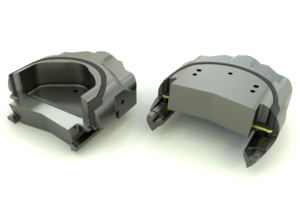BOP shear ram built to meet BSEE’s new wireline-cutting requirement
15,000-psi model already in use in GOM; new 20,000-psi version now in development and expected to launch later this year
By Ryan Gustafson and Greg Myers, Baker Hughes, a GE company
A recently implemented US requirement for subsea BOP shear rams from the Well Control Rule of the Bureau of Safety and Environmental Enforcement (BSEE) has added wireline cutting to the list of critical wellbore sealing capabilities. This is a significant departure from historical pipe-shearing capabilities.
Cutting wireline, in addition to a variety of tubulars, required an extensive testing and design program to develop the technology.

The Wireline Blind Shear Ram (WBSR) developed by Baker Hughes, a GE company (BHGE), cuts wireline and shears tubulars even without tension. It meets BSEE requirements, as well as API 16A 4th Edition PR2 qualification standards. It is also the industry’s first shear ram that meets National Association of Corrosion Engineers (NACE) corrosion standards through the pressure load path.
The ram has sheared, cut and sealed complex sub-assemblies with combinations of pipe, wireline, coiled tubing and control lines in an on-bottom condition. The 18 ¾-in., 15,000-psi model is being used in the Gulf of Mexico, as well as the United Kingdom and Latin America.
Shearing Versus Cutting
The process of shearing pipe versus cutting wire is markedly different. Shearing pipe can be likened to blunt force crushing, then fracturing of pipe, while cutting a wireline requires making a clean cut with sharp blades and maintaining precise blade gap control. Doing both reliably requires a carefully designed balance of features.
The WBSR uses no-bolt shear blades with fewer replaceable components and incorporates replaceable wear pads to increase ram block service life in harsh environments.
To consistently shear wires and cables, the design uses gap control arms to ensure a minimum gap is maintained while still being robust enough to withstand shearing a heavy wall tubular. The arms also position the tubular within the shear-blade cutting plane.
Where offshore servicing and inspection is possible, the low alloy steel wear pads located on the gap control arms can be easily checked and changed.
The ram is a drop-in upgrade to a 18 ¾-in. 15,000-psi compact ram BOP and can be installed during routine offshore operations. It builds on ram BOP model lines for all surface and subsea applications, including blind, blind shear, casing, casing shear, fixed bore, tubing and wireline shear. The ability to operate effectively, whether wellbore materials are in tension, enhances cutting performance in difficult operations, such as lost-in-hole scenarios.
Shear Design
The design process for the WBSR started in 2014 as a multidisciplinary effort, beginning with a review of existing shearing methodologies. The study focused on shearing tubulars and adapting those blade geometries to the task of cutting wireline. Factors considered include material selection, heat treat and welding processes, elastomer and seal technologies, and geometry and cutting advancements. It also relied on an extensive BHGE archive of shear data, as well as field history reports on existing designs.
To optimize wellbore pressure sealing, the non-metallic seal design team conducted studies to guide the production of the elastomer seals and reduce the number of seal prototypes to be validated. The studies included hyper-elastic, non-linear modeling to accelerate the seal development program and compare the prototype WBSR seal designs with existing validated models. The known elastomeric models were used to develop the baseline seal characteristics related to rubber flow, contact loads and geometry.
Developing the new ram required precisely balancing metallurgy and design. Considerations included a range of softer and harder metallic and non-metallic materials and its alignment with blade geometry, such as angle, width and height. The material selected for the ram block balances the metallurgical process with the block geometry to prevent structural material challenges, while maintaining NACE physical property characteristics.
In addition, attention was given to reducing high-stress areas to improve the fatigue life characteristic of the ram blocks. Finite element analysis was used to optimize blade geometry and prevent high stress areas.
The WBSR is coupled with BHGE’s multi-position locking mechanism for safety and risk mitigation. The mechanism’s clutch design holds the shear ram closed even if hydraulic pressure is lost, preventing blade retraction so the wellbore seal is maintained.
To date, more than 100 shear tests have been performed at BHGE facilities on wireline, slick line, drill pipe and casing up to 10 ¾-in. P110 85.3 lb/ft.
Tests involved combinations of shear blade design and ram prototypes and have been performed in various configurations of slack wireline, on-bottom shear subs, combination shear assemblies, off center and side load shearing.
Tests were conducted with customer and third-party witnesses who participated in multiple shearing and sealing events. Successful shearing and sealing was defined as zero fluid leakage at full pressure following prescribed cycles or shearing events.
Building on the success of the first version, BHGE is now qualifying a 20,000-psi WBSR to be released this year. DC




